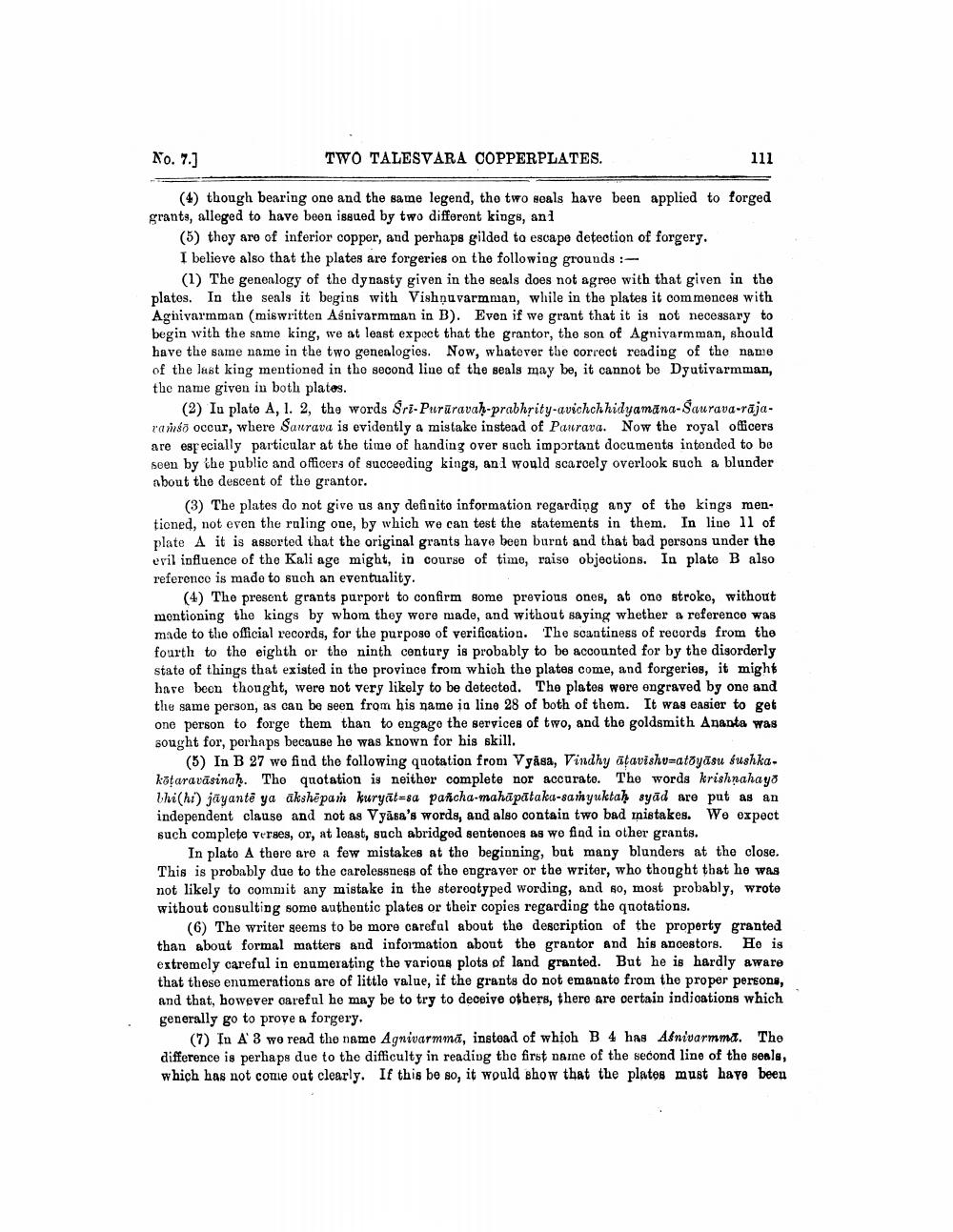________________
No. 7.]
TWO TALESVARA COPPERPLATES.
111
(4) though bearing one and the same legend, the two seals have been applied to forged grants, alleged to have been issued by two different kings, ani
(5) thoy are of inferior copper, and perhaps gilded to escape detection of forgery. I believe also that the plates are forgeries on the following grounds :
(1) The genenlogy of the dynasty given in the seals does not agree with that given in the plates. In the seals it begins with Vishnuvarmman, while in the plates it commences with Agnivarmman (miswritten Asnivarmman in B). Even if we grant that it is not necessary to begin with the same king, we at least expect that the grantor, the son of Agnivarmman, should have the same name in the two genealogies. Now, whatever the correct reading of the name of the last king mentioned in the second line of the seals may be, it cannot be Dyutivarmman, the name given in both plates.
(2) Ia plate A, 1.2, the words Sri-Purūravah-prabhrity-avichchhidyamana-Saurava-rājaraiso occur, where Saurava is evidently a mistake instead of Paurava. Now the royal officers are especially particular at the time of handing over such important documents intended to be soen by the public and officers of succeeding kings, and would scarcely overlook such a blunder about the descent of the grantor.
(3) The plates do not give us any definito information regarding any of the kinga mentioned, not even the ruling one, by which we can test the statements in them. In line 1l of plate A it is assorted that the original grants have been burnt and that bad persons under the eril influence of the Kali age might, in course of time, raise objections. In plate B also reference is made to such an eventuality.
(4) The present grants purport to confirm some previous ones, at ono stroko, without mentioning the kings by whom they were made, and without saying whether a reference was made to the official records, for the purpose of verification. The scantiness of records from the fourth to the eighth or the ninth century is probably to be accounted for by the disorderly state of things that existed in the province from which the plates come, and forgeries, it might have been thought, were not very likely to be detected. The plates were engraved by one and the same person, as can be seen from his name in line 28 of both of them. It was easier to get one person to forge them than to engage the services of two, and the goldsmith Ananta was sought for, perhaps because he was known for his skill.
(5) In B 27 we find the following quotation from Vyåsa, Vindhy atavishv=atöyāsu fushka. kāțaravāsinah. Tho quotation is neither complete nor accurate. The words krishnahayo thi(hi) jāyantē ya akshëpar kuryāt=sa pancha-mahāpataka-samyuktah syād are put as an independent clause and not as Vyāsa's words, and also contain two bad mistakes. We expect such complete verges, or, at least, such abridgod sentences as we find in other grants.
In plato A there are a few mistakes at the beginning, but many blunders at the close. This is probably due to the carelessness of the engraver or the writer, who thought that he was not likely to commit any mistake in the sterootyped wording, and so, most probably, wrote without consulting some authentic plates or their copies regarding the quotations.
(6) The writer geems to be more careful about the description of the property granted than about formal matters and information about the grantor and his ancestors. He is extremely careful in enumerating the various plots of land granted. But he is hardly aware that these enumerations are of little value, if the grants do not emanato from the proper persons, and that, however careful he may be to try to deceive others, there are certain indications which generally go to prove a forgery.
(7) In A 3 wo read the name Agnivarmmā, instead of which B 4 hag Asnivarmma. The difference is perhaps due to the difficulty in reading the first name of the second line of the seala, which has not come out clearly. If this be so, it would show that the plates must have been




